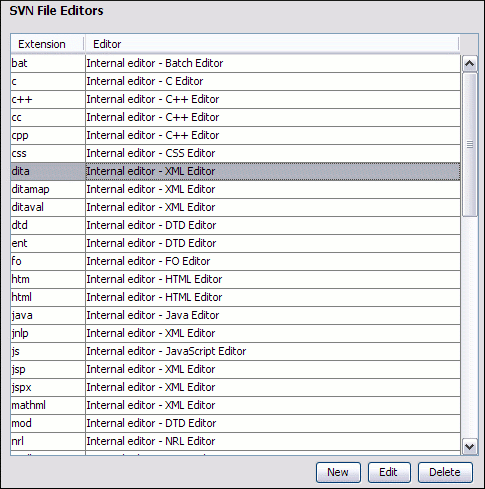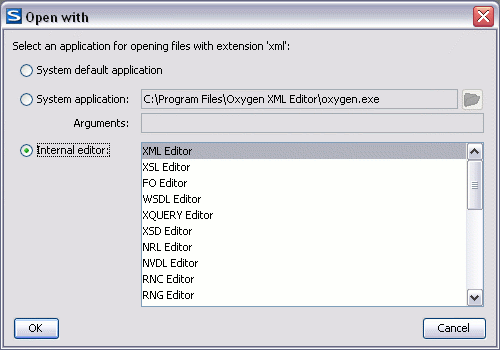Each type of file is associated with an editor which opens files of that type for editing. The editor can be the built-in one specially provided for the file type (for example the internal XML editor, the internal XSLT editor, the internal XSL-FO editor, etc) or an external application installed on the computer, either the default system application associated with that file type in the operating system or other particular application specified by the path to its executable file. The list of all the associations file type - editor is displayed in the panel SVN File Editors.
The SVN File Editors preferences panel is opened from menu → +SVN File Editors
The Edit button under the table or a double click on a table row opens a dialog for specifying the editor associated with the file type.
The same dialog is displayed and after an Open with action on a selected file from Syncro SVN Client.
In this dialog are offered three options for opening a file:
System default application - this option allows you to open the selected file using the application that is associated with that file extension by default in your operating system;
System application - opens the selected file using an external application that you have to specify by the path of its executable file. Also, you can specify some arguments for that application, if they are needed. This option also works for directories, if you wish to choose a file browser other than the system default.
Internal editor - this options allows you to select an editor type from the built in editors that Syncro SVN Client comes with. By default, this option is disabled when selecting directories.
![[Note]](img/note.gif) | Note |
|---|---|
For opening a directory, you can choose one of the first two options. The System default application will be used to open that directory in the system built-in file browser (i.e. Windows Explorer for Windows, Finder for Max OS X etc.), and the second one for opening that directory using a file browser other than the system default. |
If a file type is associated with an internal editor other than the XML Editor then the encoding set in the preference Encoding for non XML files is used for opening and saving a file of that type. This is necessary because in case of XML files the encoding is usually declared at the beginning of the XML file in a special declaration or it assumes the default value UTF-8 but in case of non XML files there is no standard mechanism for declaring the encoding of the file.


